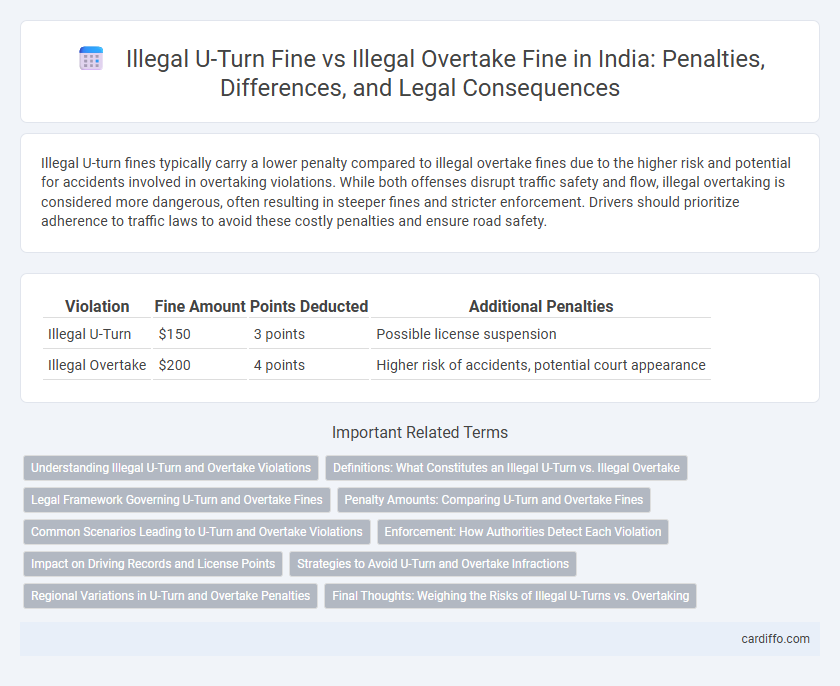Illegal U-turn fines typically carry a lower penalty compared to illegal overtake fines due to the higher risk and potential for accidents involved in overtaking violations. While both offenses disrupt traffic safety and flow, illegal overtaking is considered more dangerous, often resulting in steeper fines and stricter enforcement. Drivers should prioritize adherence to traffic laws to avoid these costly penalties and ensure road safety.
Table of Comparison
| Violation | Fine Amount | Points Deducted | Additional Penalties |
|---|---|---|---|
| Illegal U-Turn | $150 | 3 points | Possible license suspension |
| Illegal Overtake | $200 | 4 points | Higher risk of accidents, potential court appearance |
Understanding Illegal U-Turn and Overtake Violations
Illegal U-turn violations typically result in fines ranging from $100 to $250, reflecting the potential hazards of sudden direction changes on busy roads. Illegal overtaking fines are often higher, usually between $150 and $300, due to the increased risk of collisions when passing in restricted zones. Understanding the specific penalties helps drivers comply with traffic laws and enhances road safety by discouraging dangerous maneuvers.
Definitions: What Constitutes an Illegal U-Turn vs. Illegal Overtake
An illegal U-turn occurs when a driver reverses direction by turning their vehicle in a prohibited area or where road signs explicitly forbid such maneuvers. An illegal overtake involves passing another vehicle in unsafe or restricted zones, such as no-passing sections, blind curves, or intersections. Both violations disrupt traffic flow and endanger road safety but differ in the specific prohibited actions and locations defined by traffic regulations.
Legal Framework Governing U-Turn and Overtake Fines
The legal framework governing fines for illegal U-turns and overtaking is established under traffic regulations that define specific offenses and penalties to ensure road safety. Illegal U-turn fines are typically imposed for executing a turn against traffic rules, marked by signage or road markings, while illegal overtaking fines address dangerous passing maneuvers that compromise safety. Statutory provisions often differentiate these violations by their risk levels and prescribe distinct fines, points deductions, and potential license suspensions.
Penalty Amounts: Comparing U-Turn and Overtake Fines
Illegal U-turn fines typically range from $100 to $200, depending on the jurisdiction, while illegal overtake penalties are often higher, ranging from $150 to $300, reflecting the increased risk associated with overtaking maneuvers. Both violations may carry additional consequences such as license points or suspension, but overtaking violations usually result in more severe penalties due to the greater danger posed to traffic safety. Enforcement agencies prioritize these fines to deter risky behavior, ensuring road compliance and minimizing accident rates.
Common Scenarios Leading to U-Turn and Overtake Violations
Common scenarios leading to illegal U-turn violations include making turns at prohibited intersections, ignoring no U-turn signage, and attempting U-turns on busy highways or school zones. Illegal overtake fines often result from overtaking in no-overtaking zones, on blind curves, or within pedestrian crossings where visibility and safety are compromised. Both violations significantly increase accident risk and are strictly enforced with fines to promote road safety.
Enforcement: How Authorities Detect Each Violation
Enforcement of illegal U-turn violations often relies on strategically placed cameras at intersections and on road medians, enabling authorities to capture clear images of vehicles making unauthorized turns. Illegal overtaking detection utilizes speed and lane monitoring technologies, including radar guns and infrared sensors, to identify vehicles crossing solid lines or exceeding speed limits in restricted zones. Traffic patrol officers frequently use direct observation combined with dashcam footage to corroborate violations for both illegal U-turns and illegal overtaking incidents.
Impact on Driving Records and License Points
Illegal U-turn fines often result in moderate points added to a driver's license, which accumulate and may lead to increased insurance premiums and potential license suspension if repeated offenses occur. Illegal overtaking violations typically carry higher point penalties due to the greater risk involved, significantly impacting a driving record and accelerating the path to license suspension. Both infractions negatively affect a driver's record but illegal overtaking usually has a more severe consequence on license points and long-term driving privileges.
Strategies to Avoid U-Turn and Overtake Infractions
To minimize illegal U-turn and overtaking fines, drivers should strictly adhere to traffic signs and road markings indicating permissible maneuvers. Employing defensive driving techniques, such as maintaining safe following distances and anticipating traffic flow, reduces the temptation for risky lane changes or U-turns. Utilizing navigation apps with real-time traffic updates helps identify legal routes and avoid areas prone to infractions.
Regional Variations in U-Turn and Overtake Penalties
Regional variations in illegal U-turn fines range from $50 to $200, reflecting local traffic enforcement priorities and road safety concerns. Illegal overtake penalties often exceed U-turn fines, with fines varying between $100 and $400, highlighting stricter regulation due to higher accident risks. Some jurisdictions impose additional points on drivers' licenses for these violations, intensifying consequences based on regional traffic laws.
Final Thoughts: Weighing the Risks of Illegal U-Turns vs. Overtaking
Illegal u-turn fines typically reflect the increased risk of sudden, dangerous maneuvers that can cause head-on collisions or side impacts, with penalties often higher due to the potential for severe accidents. Conversely, illegal overtaking fines are frequently imposed to discourage risky passing maneuvers that may result in multi-vehicle collisions, especially on two-lane roads or highways with limited visibility. Evaluating the severity and likelihood of accidents linked to each violation highlights why legal enforcement emphasizes stricter penalties for illegal u-turns compared to illegal overtaking in many jurisdictions.
illegal u-turn fine vs illegal overtake fine Infographic

 cardiffo.com
cardiffo.com